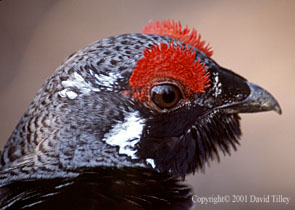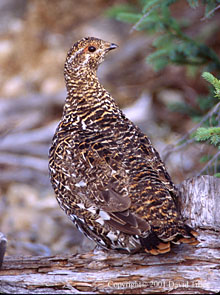Nobodies Fool (Meet the Spruce Grouse)
Reprinted from "The Nfld Sportsman" (Jan - Feb. 98) (Copyright © 1998 David Tilley)
The Spruce Grouse was introduced to Nfld. in the early sixties and as become well established in areas where spruce and fir trees dominate. Dubbed "fool hen" because of their tameness and reluctance to be supplanted from a favourite perch they are easy prey for human hunters. They seem to fair better against other predators staying well hidden from birds of prey and out of reach of foxes by perching on the stocky limbs of spruce and fir trees where there speckled plumage is difficult to detect against the roughened bark. They have a special significance for any one who likes to take a camera in the woods because of the relative ease with which they can be photographed. 
As soon as the ponds are open for trouting in the spring and the lure of the woods is greatest in the hearts of winterworn residents, these birds are equally enraptured with the ceremony of mating. Traditional stomping grounds are revisited year after year by generations of grouse each in turn flying madly about the perimeter of a sacred territory and parading on the ground, challenging all comers, with or without feathers in defence of a soon to nest hen. It seems to please the male to no end to have a human visitor who approaches without any particular threat to witness this hormone crazed show of boldness since a hidden hen can appraise this admirable although somewhat dubious display as the characteristics of a superior mate. The parading and fanning of feathers of the male spruce grouse is reminiscent of ancient native tribal dances and their darkened speckled plumage is worthy of serious photography. This "peacock" of Newfoundland game birds appears to love having its picture taken. I have managed frame filling shots with a 24mm lens, giving the advantage of wide angle distortion and a in focus background of mature woods, a near impossibility with other wildlife. These pictures show a proud display of feathers and fearlessness. I have even witnessed birds in the fall who fly out into the open to distract hunters from a mate, thus making the ultimate sacrifice.
 Many people find the dark meat of these birds who diet on a plentiful supply of conifer needles to be similar in taste to the needles themselves. These people probably don′t drink spruce tea either, despite its nutritional value. The meat is extremely tender and if the bird is not shot with a full crop of needles, such as in the late hours of the day when it will be feeding in its favourite tree, it is often quite tasty. I always use a bow and a special arrow adapted for short range and recovery when hunting small game. FluFlus can be hand made at relatively low cost by gluing large feathers to wooden shafts with a rubber blunt and plastic nock at either end. The size and bright colour of the feathers slows the arrow and makes it easy to recover from dense thickets. It helps to plan shots in order to avoid splitting arrows on heavy limbs and tree trunks or clearing the bushes and increasing range.
Many people find the dark meat of these birds who diet on a plentiful supply of conifer needles to be similar in taste to the needles themselves. These people probably don′t drink spruce tea either, despite its nutritional value. The meat is extremely tender and if the bird is not shot with a full crop of needles, such as in the late hours of the day when it will be feeding in its favourite tree, it is often quite tasty. I always use a bow and a special arrow adapted for short range and recovery when hunting small game. FluFlus can be hand made at relatively low cost by gluing large feathers to wooden shafts with a rubber blunt and plastic nock at either end. The size and bright colour of the feathers slows the arrow and makes it easy to recover from dense thickets. It helps to plan shots in order to avoid splitting arrows on heavy limbs and tree trunks or clearing the bushes and increasing range.
 It may seem hypocritical to attempt to earn the "trust" of these birds in the spring for photography only to shoot them in the fall for additional sport and meat. In fact the grouse is a bird that requires a large territory which it defends from rivals. It is subject to heavy predation in the fall when young inexperienced birds try to establish in areas limited by the amount of habitat available. Unsuccessful birds are found along roadsides in areas frequented by hunters. These birds have limited chances for survival and nature compensates for the poor success rate with broods that number from 9-13 in spring.
So regardless of name and lack of sophistication, the spruce grouse has arrived and will continue to provide people who use the woods in the province with a rare glimpse of wild spirit.
It may seem hypocritical to attempt to earn the "trust" of these birds in the spring for photography only to shoot them in the fall for additional sport and meat. In fact the grouse is a bird that requires a large territory which it defends from rivals. It is subject to heavy predation in the fall when young inexperienced birds try to establish in areas limited by the amount of habitat available. Unsuccessful birds are found along roadsides in areas frequented by hunters. These birds have limited chances for survival and nature compensates for the poor success rate with broods that number from 9-13 in spring.
So regardless of name and lack of sophistication, the spruce grouse has arrived and will continue to provide people who use the woods in the province with a rare glimpse of wild spirit.
